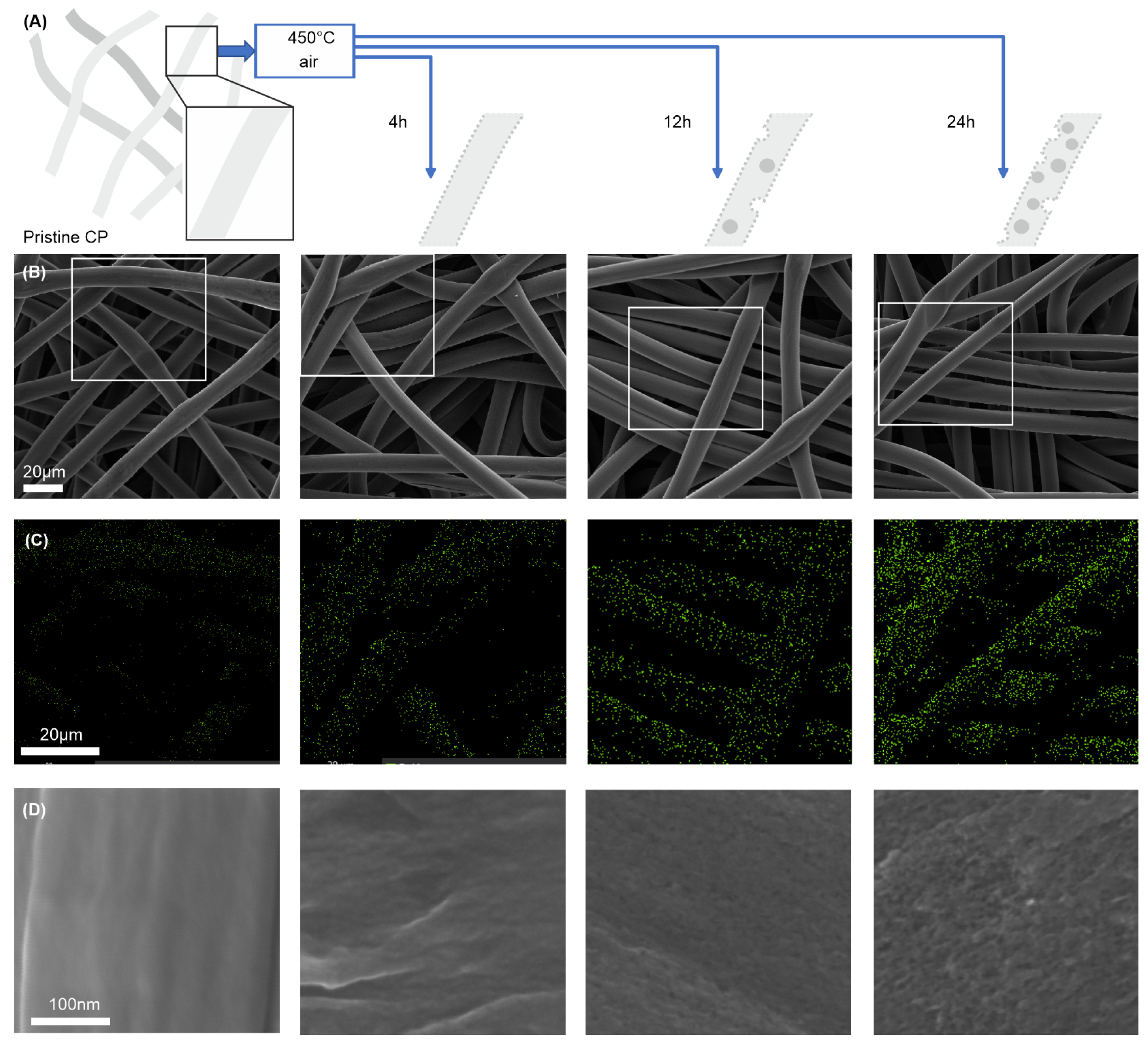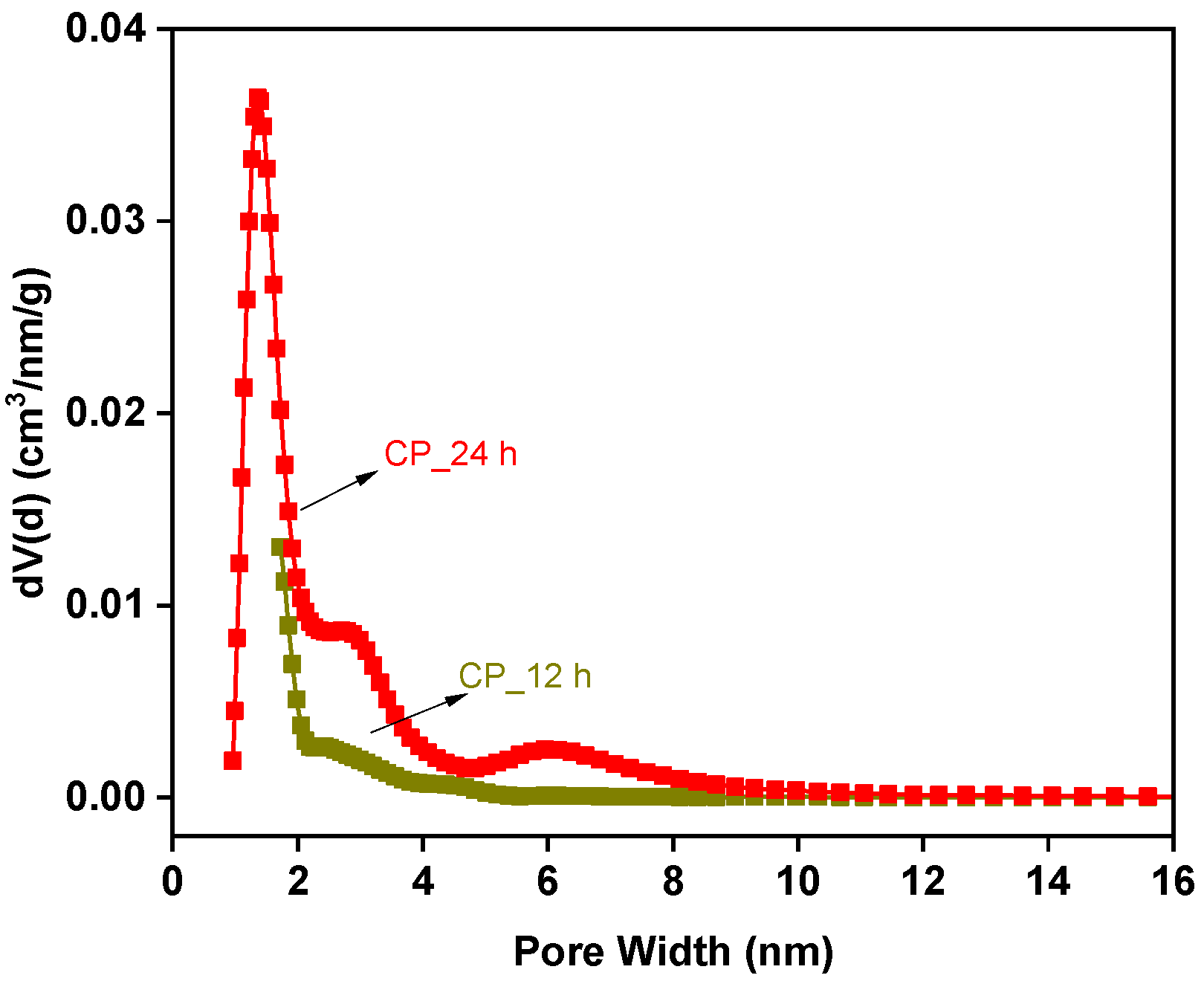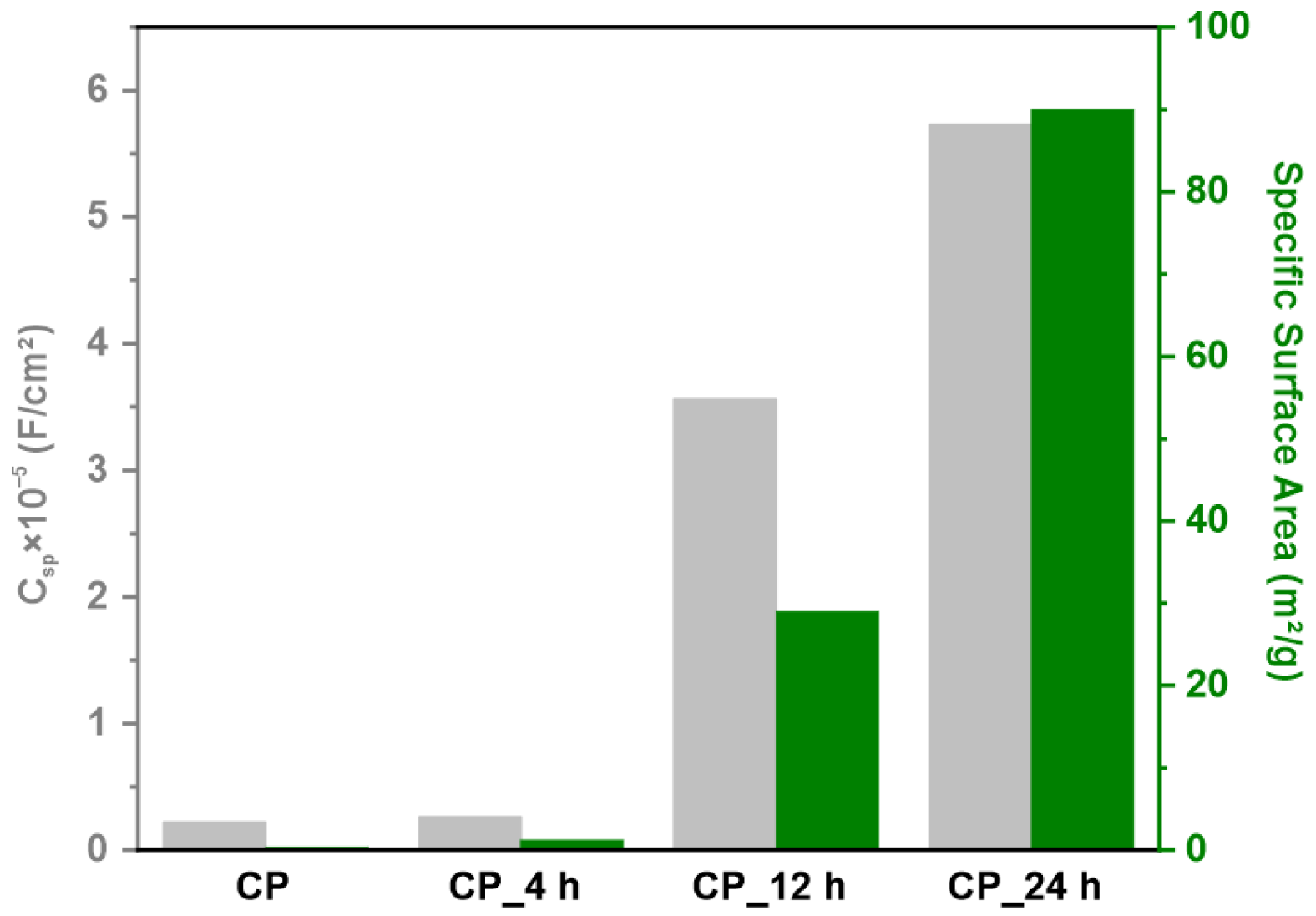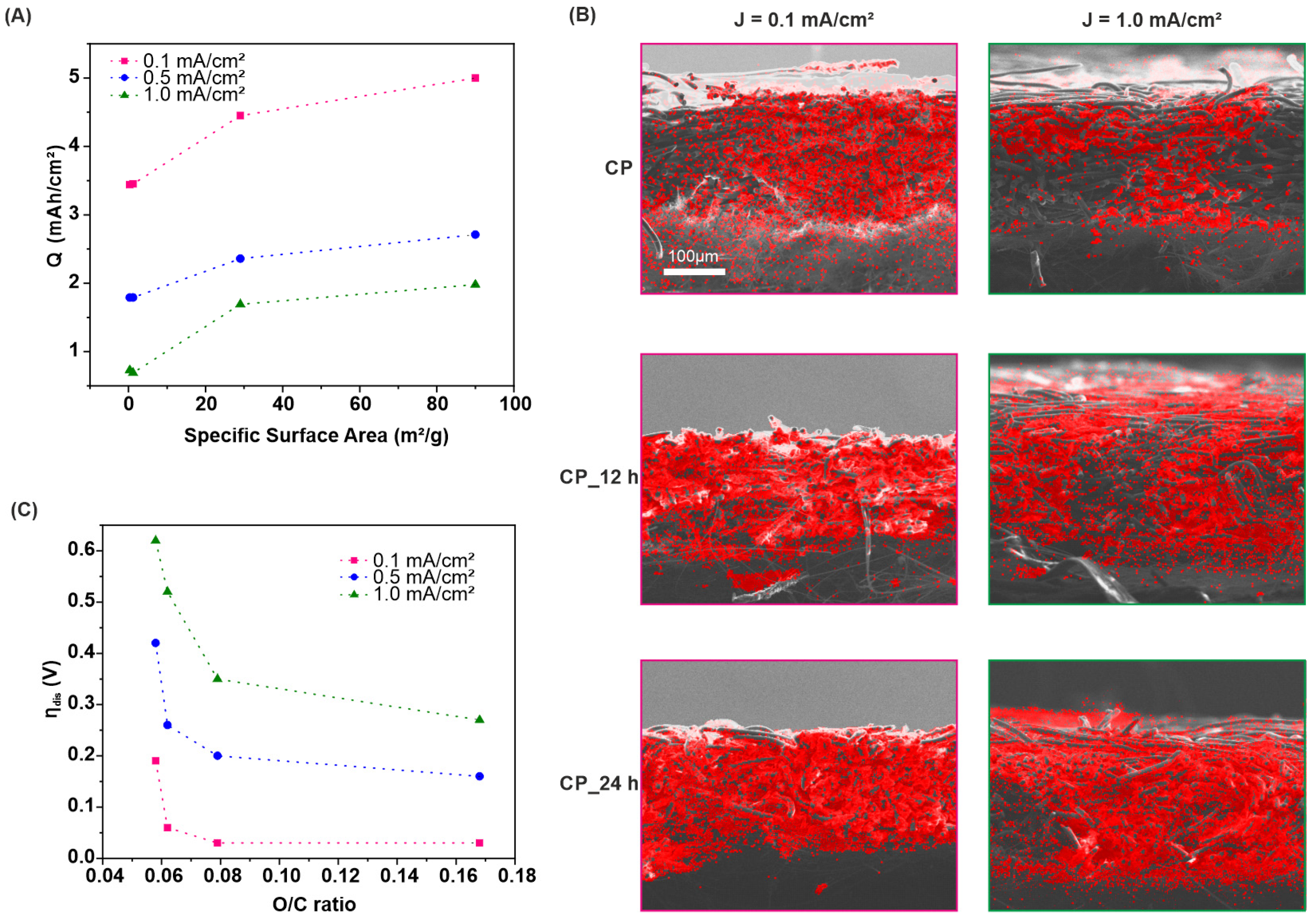Hierarchical Porosity and Surface Oxygenation of Carbon-Based Cathodes Enhances Discharge Capacity and Decreases Discharge Overpotential of Potassium–Oxygen Batteries
Abstract
:1. Introduction
2. Materials and Methods
2.1. Thermal Oxidation of Carbon Paper
2.2. Characterization
2.3. Battery Cell Assembly
2.4. Electrochemical Measurements
2.5. Analysis Methods Post Discharge
3. Results and Discussion
3.1. Thermal Oxidation of Carbon Paper
3.1.1. Analysis of Cathode Structure and Surface Properties
3.1.2. Analysis of Surface Area
3.2. Electrochemical Measurements
4. Conclusions
Supplementary Materials
Author Contributions
Funding
Data Availability Statement
Acknowledgments
Conflicts of Interest
References
- Choi, N.S.; Chen, Z.; Freunberger, S.A.; Ji, X.; Sun, Y.K.; Amine, K.; Yushin, G.; Nazar, L.F.; Cho, J.; Bruce, P.G. Challenges facing lithium batteries and electrical double-layer capacitors. Angew. Chem. Int. Ed. Engl. 2012, 51, 9994–10024. [Google Scholar] [CrossRef]
- Girishkumar, G.; McCloskey, B.; Luntz, A.C.; Swanson, S.; Wilcke, W. Lithium−Air Battery: Promise and Challenges. J. Phys. Chem. Lett. 2010, 1, 2193–2203. [Google Scholar] [CrossRef]
- Ren, X.; Wu, Y. A low-overpotential potassium-oxygen battery based on potassium superoxide. J. Am. Chem. Soc. 2013, 135, 2923–2926. [Google Scholar] [CrossRef]
- Aurbach, D.; McCloskey, B.D.; Nazar, L.F.; Bruce, P.G. Advances in understanding mechanisms underpinning lithium—Air batteries. Nat. Energy 2016, 1, 16128. [Google Scholar] [CrossRef]
- Yao, X.; Dong, Q.; Cheng, Q.; Wang, D. Why Do Lithium–Oxygen Batteries Fail: Parasitic Chemical Reactions and Their Synergistic Effect. Angew. Chem. Int. Ed. 2016, 55, 11344–11353. [Google Scholar] [CrossRef]
- Mahne, N.; Schafzahl, B.; Leypold, C.; Leypold, M.; Grumm, S.; Leitgeb, A.; Strohmeier; Gernot, A.; Wilkening, M.; Fontaine, O.; et al. Singlet oxygen generation as a major cause for parasitic reactions during cycling of aprotic lithium–oxygen batteries. Nat. Energy 2017, 2, 17036. [Google Scholar] [CrossRef]
- Mourad, E.; Petit, Y.K.; Spezia, R.; Samojlov, A.; Summa, F.F.; Prehal, C.; Leypold, C.; Mahne, N.; Slugovc, C.; Fontaine, O.; et al. Singlet oxygen from cation driven superoxide disproportionation and consequences for aprotic metal–O2 batteries. Energy Environ. Sci. 2019, 12, 2559–2568. [Google Scholar] [CrossRef]
- Houchins, G.; Pande, V.; Viswanathan, V. Mechanism for Singlet Oxygen Production in Li-Ion and Metal–Air Batteries. ACS Energy Lett. 2020, 5, 1893–1899. [Google Scholar] [CrossRef]
- Reinsberg, P.H.; Koellisch, A.; Baltruschat, H. On the importance of ion pair formation and the effect of water in potassium—Oxygen batteries. Electrochim. Acta 2019, 313, 223–234. [Google Scholar] [CrossRef]
- Xiao, N.; Rooney, R.T.; Gewirth, A.A.; Wu, Y. The Long-Term Stability of KO2 in K-O2 Batteries. Angew. Chem. Int. Ed. 2018, 57, 1227–1231. [Google Scholar] [CrossRef]
- Qin, L.; Schkeryantz, L.; Zheng, J.; Xiao, N.; Wu, Y. Superoxide-Based K–O2 Batteries: Highly Reversible Oxygen Redox Solves Challenges in Air Electrodes. J. Am. Chem. Soc. 2020, 142, 11629–11640. [Google Scholar] [CrossRef]
- Xiao, N.; Ren, X.; McCulloch, W.D.; Gourdin, G.; Wu, Y. Potassium Superoxide: A Unique Alternative for Metal–Air Batteries. Acc. Chem. Res. 2018, 51, 2335–2343. [Google Scholar] [CrossRef]
- Park, J.; Hwang, J.-Y.; Kwak, W.-J. Potassium–Oxygen Batteries: Significance, Challenges, and Prospects. J. Phys. Chem. Lett. 2020, 11, 7849–7856. [Google Scholar] [CrossRef]
- Ren, X.; Lau, K.C.; Yu, M.; Bi, X.; Kreidler, E.; Curtiss, L.A.; Wu, Y. Understanding Side Reactions in K–O2 Batteries for Improved Cycle Life. ACS Appl. Mater. Interfaces 2014, 6, 19299–19307. [Google Scholar] [CrossRef]
- Yu, W.; Lau, K.C.; Lei, Y.; Liu, R.; Qin, L.; Yang, W.; Li, B.; Curtiss, L.A.; Zhai, D.; Kang, F. Dendrite-Free Potassium–Oxygen Battery Based on a Liquid Alloy Anode. ACS Appl. Mater. Interfaces 2017, 9, 31871–31878. [Google Scholar] [CrossRef]
- McCulloch, W.D.; Ren, X.; Yu, M.; Huang, Z.; Wu, Y. Potassium-Ion Oxygen Battery Based on a High Capacity Antimony Anode. ACS Appl. Mater. Interfaces 2015, 7, 26158–26166. [Google Scholar] [CrossRef]
- Eftekhari, A.; Jian, Z.; Ji, X. Potassium Secondary Batteries. ACS Appl. Mater. Interfaces 2017, 9, 4404–4419. [Google Scholar] [CrossRef]
- Xiao, N.; Gourdin, G.; Wu, Y. Simultaneous Stabilization of Potassium Metal and Superoxide in K–O2 Batteries on the Basis of Electrolyte Reactivity. Angew. Chem. Int. Ed. 2018, 57, 10864–10867. [Google Scholar] [CrossRef]
- Gilmore, P.; Sundaresan, V.B. A Functionally Graded Cathode Architecture for Extending the Cycle-Life of Potassium-Oxygen Batteries. Batter. Supercaps 2019, 2, 662. [Google Scholar] [CrossRef]
- Cong, G.; Wang, W.; Lai, N.-C.; Liang, Z.; Lu, Y.-C. A high-rate and long-life organic–oxygen battery. Nat. Mater. 2019, 18, 390–396. [Google Scholar] [CrossRef]
- Küpper, J.; Jakobi, S.; Simon, U. PTFE Enhances Discharge Performance of Carbon Cathodes in Potassium-Oxygen Batteries. Batter. Supercaps 2021, 4, 1620–1626. [Google Scholar] [CrossRef]
- Küpper, J.; Simon, U. The effects of oxygen pressure on the discharge performance of potassium—Oxygen batteries. Sustain. Energy Fuels 2022, 6, 1992–2000. [Google Scholar] [CrossRef]
- Küpper, J.; Li, X.; Simon, U. A Model of the Potassium-Oxygen Battery and its Application in Cathode Design. J. Electrochem. Soc. 2022, 169, 060539. [Google Scholar] [CrossRef]
- Singh, A.; Yasri, N.; Karan, K.; Roberts, E. Electrocatalytic Activity of Functionalized Carbon Paper Electrodes and Their Correlation to the Fermi Level Derived from Raman Spectra. ACS Appl. Energy Mater. 2019, 2, 2324–2336. [Google Scholar] [CrossRef]
- Yue, Z.R.; Jiang, W.; Wang, L.; Gardner, S.D.; Pittman, C.U. Surface characterization of electrochemically oxidized carbon fibers. Carbon 1999, 37, 1785–1796. [Google Scholar] [CrossRef]
- Qian, Z.; Sun, B.; Du, L.; Lou, S.; Du, C.; Zuo, P.; Ma, Y.; Cheng, X.; Gao, Y.; Yin, G. Insights into the role of oxygen functional groups and defects in the rechargeable nonaqueous Li–O2 batteries. Electrochim. Acta 2018, 292, 838–845. [Google Scholar] [CrossRef]
- Li, Z.; Deng, L.; Kinloch, I.A.; Young, R.J. Raman spectroscopy of carbon materials and their composites: Graphene, nanotubes and fibres. Prog. Mater. Sci. 2023, 135, 101089. [Google Scholar] [CrossRef]
- Stankovich, S.; Dikin, D.A.; Piner, R.D.; Kohlhaas, K.A.; Kleinhammes, A.; Jia, Y.; Wu, Y.; Nguyen, S.T.; Ruoff, R.S. Synthesis of graphene-based nanosheets via chemical reduction of exfoliated graphite oxide. Carbon 2007, 45, 1558–1565. [Google Scholar] [CrossRef]
- Kwon, S.; Suharto, Y.; Kim, K.J. Facile preparation of an oxygen-functionalized carbon felt electrode to improve VO2+/VO2+ redox chemistry in vanadium redox flow batteries. J. Ind. Eng. Chem. 2021, 98, 231–236. [Google Scholar] [CrossRef]
- Liu, T.; Li, X.; Xu, C.; Zhang, H. Activated Carbon Fiber Paper Based Electrodes with High Electrocatalytic Activity for Vanadium Flow Batteries with Improved Power Density. ACS Appl. Mater. Interfaces 2017, 9, 4626–4633. [Google Scholar] [CrossRef]
- Ulaganathan, M.; Aravindan, V.; Yan, Q.; Madhavi, S.; Skyllas-Kazacos, M.; Lim, T.M. Recent Advancements in All-Vanadium Redox Flow Batteries. Adv. Mater. Interfaces 2016, 3, 1500309. [Google Scholar] [CrossRef]
- Zeng, L.; Zhao, T.; Wei, L. Revealing the Performance Enhancement of Oxygenated Carbonaceous Materials for Vanadium Redox Flow Batteries: Functional Groups or Specific Surface Area? Adv. Sustain. Syst. 2018, 2, 1700148. [Google Scholar] [CrossRef]
- Yang, S.; Li, L.; Xiao, T.; Zheng, D.; Zhang, Y. Role of surface chemistry in modified ACF (activated carbon fiber)-catalyzed peroxymonosulfate oxidation. Appl. Surf. Sci. 2016, 383, 142–150. [Google Scholar] [CrossRef]
- Pacheco, F.G.; Cotta, A.A.C.; Gorgulho, H.F.; Santos, A.P.; Macedo, W.A.A.; Furtado, C.A. Comparative temporal analysis of multiwalled carbon nanotube oxidation reactions: Evaluating chemical modifications on true nanotube surface. Appl. Surf. Sci. 2015, 357, 1015–1023. [Google Scholar] [CrossRef]
- Knudsen, K.B.; Nichols, J.E.; Vegge, T.; Luntz, A.C.; McCloskey, B.D.; Hjelm, J. An Electrochemical Impedance Study of the Capacity Limitations in Na–O2 Cells. J. Phys. Chem. C 2016, 120, 10799–10805. [Google Scholar] [CrossRef]
- Wang, F.; Li, X. Effects of the Electrode Wettability on the Deep Discharge Capacity of Li–O2 Batteries. ACS Omega 2018, 3, 6006–6012. [Google Scholar] [CrossRef]
- Riaz, A.; Jung, K.-N.; Lee, J.-W. A Mini-Review on Non-Aqueous Lithium-Oxygen Batteries—Electrochemistry and Cathode Materials. J. Electrochem. Sci. Technol. 2015, 6, 50–58. [Google Scholar] [CrossRef]
- Kim, M.; Yoo, E.; Ahn, W.-S.; Shim, S.E. Controlling porosity of porous carbon cathode for lithium oxygen batteries: Influence of micro and meso porosity. J. Power Sources 2018, 389, 20–27. [Google Scholar] [CrossRef]
- Zhao, T.; Yao, Y.; Yuan, Y.; Wang, M.; Wu, F.; Amine, K.; Lu, J. A universal method to fabricating porous carbon for Li-O2 battery. Nano Energy 2021, 82, 105782. [Google Scholar] [CrossRef]
- Huang, S.; Fan, W.; Guo, X.; Meng, F.; Liu, X. Positive role of surface defects on carbon nanotube cathodes in overpotential and capacity retention of rechargeable lithium-oxygen batteries. ACS Appl. Mater. Interfaces 2014, 6, 21567–21575. [Google Scholar] [CrossRef]
- Xiao, J.; Mei, D.; Li, X.; Xu, W.; Wang, D.; Graff, G.L.; Bennett, W.D.; Nie, Z.; Saraf, L.V.; Aksay, I.A.; et al. Hierarchically Porous Graphene as a Lithium–Air Battery Electrode. Nano Lett. 2011, 11, 5071–5078. [Google Scholar] [CrossRef]






| Cathode Sample | Micropore Area (m2/g) | External Surface Area (m2/g) | Specific Surface Area (m2/g) |
|---|---|---|---|
| CP | - | - | 0.33 |
| CP_4 h | - | - | 1.2 |
| CP_12 h | 26 | 3 | 29 |
| CP_24 h | 75.7 | 18.2 | 90 |
Disclaimer/Publisher’s Note: The statements, opinions and data contained in all publications are solely those of the individual author(s) and contributor(s) and not of MDPI and/or the editor(s). MDPI and/or the editor(s) disclaim responsibility for any injury to people or property resulting from any ideas, methods, instructions or products referred to in the content. |
© 2024 by the authors. Licensee MDPI, Basel, Switzerland. This article is an open access article distributed under the terms and conditions of the Creative Commons Attribution (CC BY) license (https://creativecommons.org/licenses/by/4.0/).
Share and Cite
Singh, S.; Küpper, J.; Abouserie, A.; Dalfollo, G.; Noyong, M.; Simon, U. Hierarchical Porosity and Surface Oxygenation of Carbon-Based Cathodes Enhances Discharge Capacity and Decreases Discharge Overpotential of Potassium–Oxygen Batteries. Batteries 2024, 10, 192. https://doi.org/10.3390/batteries10060192
Singh S, Küpper J, Abouserie A, Dalfollo G, Noyong M, Simon U. Hierarchical Porosity and Surface Oxygenation of Carbon-Based Cathodes Enhances Discharge Capacity and Decreases Discharge Overpotential of Potassium–Oxygen Batteries. Batteries. 2024; 10(6):192. https://doi.org/10.3390/batteries10060192
Chicago/Turabian StyleSingh, Shikha, Jannis Küpper, Ahed Abouserie, Gianluca Dalfollo, Michael Noyong, and Ulrich Simon. 2024. "Hierarchical Porosity and Surface Oxygenation of Carbon-Based Cathodes Enhances Discharge Capacity and Decreases Discharge Overpotential of Potassium–Oxygen Batteries" Batteries 10, no. 6: 192. https://doi.org/10.3390/batteries10060192
APA StyleSingh, S., Küpper, J., Abouserie, A., Dalfollo, G., Noyong, M., & Simon, U. (2024). Hierarchical Porosity and Surface Oxygenation of Carbon-Based Cathodes Enhances Discharge Capacity and Decreases Discharge Overpotential of Potassium–Oxygen Batteries. Batteries, 10(6), 192. https://doi.org/10.3390/batteries10060192







